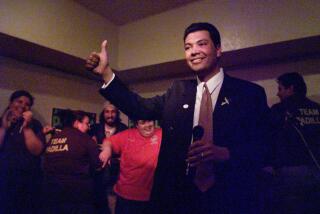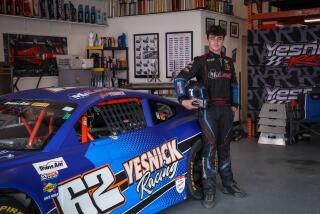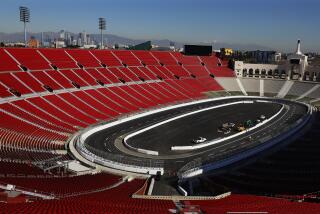A city that speed calls home
Hot rodder Jimmy Shine’s tattoo-covered arms are elbows-deep under the hood of a 1932 Ford as he adjusts the electrical wiring on a $100,000 racing engine that hasn’t started in years.
Before a co-worker turns the ignition, Shine glances uneasily at the small red fire extinguisher standing near his feet. Suddenly, the V-8 sputters and wheezes, the noise echoing off the garage’s cinder block walls. Then it stops cold.
“It’s being a little difficult today,” he says, smiling. “But we’ll get it figured out.”
The pressure is mounting for Shine and the rest of the crew at So-Cal Speed Shop in Pomona to put the final touches on the immense hot rod show car that’s been five years in the making. The car’s owner has poured hundreds of thousands of dollars into building a masterpiece: a one-of-a-kind motor, hand-stitched leather interior and flawless body work. The delivery date is just days away.
“It’s got to be perfect,” Shine said. “That’s what we’re all about. You want a hot rod, you come to Pomona.”
Pomona — population 150,119 — is home of the L.A. County Fair, Cal Poly Pomona and a reinvigorated downtown. But the city is just as known as a center for Southern California’s hot rod culture, especially since other cities paved over their drag strips and racetracks and sold the land to developers.
The Fairplex has the largest high-profile hot rod races and shows in the world. Hundreds of thousands of people come each year — filling hotels, restaurants and shops — to visit the hot rod museum and attend events such as the Grand National Roadster Show, Swap Meet and Car Show, and the L.A. Roadster Show.
Center stage is the quarter-mile drag strip officially named the Auto Club Raceway in Pomona. Since the 1950s, dragsters have locked in duels here, roaring down the 1,320-foot band of asphalt to ever-increasing speeds.
It’s a place where legendary drag racers like such as “Big Daddy” Don Garlits, Shirley “Cha Cha” Muldowney, as well as arch-rivals Don “the Snake” Prudhomme and Tom “the Mongoose” McEwen, made a name for themselves, hitting speeds in excess of 300 mph.
Daytona Beach has NASCAR. Indianapolis has the IndyCar. Pomona has the hot rod.
The National Hot Rod Assn. begins and ends every season at the famed drag strip. But that has created tension with neighbors, as engines with 7,000 horsepower scream at 145 decibels — louder than a jet engine.
Pomona has an easier relationship with hot rod shops, which build show cars for wealthy auto buffs and manufacture speed parts for the racing set.
The after-market auto business is responsible for about 3,600 jobs in and around Pomona. There are 120 of these companies with combined annual sales of $250 million, according to an industry marketing association.
Less than five miles from the Fairplex drag strip, So-Cal Speed Shop’s main garage is bustling with stubble-faced mechanics modifying cars that had rolled off assembly lines decades earlier. Engines, wheels and half-built hot rods are spread throughout the room.
A silver 1927 Roadster and a black 1958 Ford Thunderbird are parked along the right wall. In the center is the silver 1932 Ford Coupe that Shine couldn’t start. After his team replaced a carburetor part, the engine fired up and kept running.
::
Eight exhibit halls at Pomona Fairplex were packed in late January with rows of vintage cars painted in electric yellow, flaming orange and cherry red and other colors. It was the Grand National Roadster Show, and clusters of baby boomers gathered around a maroon roadster and reminisced about similar cars, using terms such as “trick,” and “bitchin” and phrases such as “go like hell.”
These are the fantasy cars of their youth: built in Detroit and modified in Southern California, during a time when ducktail hairdos, pork chop sideburns and white T-shirts were as much a part of the subculture as the cars themselves.
The start of the hot rod scene can be traced to the 1940s as soldiers returned from World War II. Hot rods became a hobby for the veterans, an outlet for skills honed while working on P-51 fighter planes or tuning up Jeeps in the motor pool.
The first testing grounds were in Southern California’s remote dry lakes, where unofficial races took place with crudely customized automobiles.
These weekend mechanics soon began swapping parts and performing surgery such as bolting a streamlined 1929 Ford body to a wider frame to make room for a larger engine and provide more stability at high speeds.
Before long, the races migrated to city streets.
Not wanting to have roadsters scream through quiet neighborhoods, Pomona gave up the northwest corner of the L.A. County Fair Grounds parking lot for use as a drag strip. The NHRA, one of the nation’s first racing organizations, was started here in 1951 by Wally Parks as a governing body to organize and promote drag racing as a sport.
The Pomona strip was an immediate success. Ralph Parker, Pomona’s then-police chief, told a magazine in 1953: “The hot rodder is no longer a problem in Pomona. He is part of the program.”
Designated drag strips popped up in Long Beach, San Gabriel, Colton, San Fernando, Santa Ana and other Southern California towns. Teenagers started car clubs with names such as the Santa Ana Outlaws, Oceanside Sea Horses and Pomona Choppers.
“The proving ground for these cars is the drag strip, and Pomona has long been ground zero,” said Steve Magnante, analyst for the auto sports channel Speed.
Specialty shops began making crankshafts, pistons and cylinder heads to boost engine power to record levels.
By the late 1960s and early ‘70s, specially built dragsters dominated NHRA races. The long, spindly machines requiring unique mixtures had replaced the souped-up Detroit-built cars. The cost of participating in the sport became too high for average enthusiasts, and racers had to look for corporate sponsors, which drew publicity and eventually broadened the fan base.
Today, the Fairplex has two grandstands flanking the drag strip with a total of 40,000 seats, and the NHRA’s competitions and car shows that take place there each year produce about $2 million in revenue.
In February, the NHRA held the Winternationals, four days of drag races that open the season. As race time neared each day, lines of cars snaked through the parking lot and waves of people climbed into the grandstands.
When the starting light glows green, the bone-shaking roar of the dueling dragsters’ nitromethane fueled engines fills the show ground each time they race the quarter-mile toward the finish line. As the dragsters’ parachutes deploy and slow them to a stop, the crowd whoops and hollers.
“The life blood of our city is nitromethane,” said Elliott Rothman, mayor of Pomona. “We’re the drag racing capital of United States. It’s good for our economy. And that’s good for everyone in our community.”
The starting line isn’t very far from La Verne, a community of 33,000 that threatened to sue the Fairplex and raceway in 2000 over noise and traffic. The litigation was dropped after Pomona agreed to build a tower behind the starting line and the second grandstand to muffle the roar of engines, develop a predictable schedule and allowed La Verne to host the association’s fan fest — a one-day event where NHRA racers sign autographs and display their cars.
“It’s not a perfect situation,” said Hal Fredericksen, La Verne’s community development director. “But it’s a lot better than it used to be.”
::
Pomona allows only 15 race days a year, but the hot rod culture is evident year-round. Classic cars are everywhere: pulling into driveways, gassing up at filling stations or cruising through town.
So-Cal Speed Shop’s owner, Pete Chapouris, 70, said it’s part of the city’s makeup.
“Hot rodding is a lifestyle, it’s not a fad,” Chapouris said. “People will always be interested in these cars. We are Americana, just like baseball and apple pie.”
Chapouris’ show car customers are finicky. Before a drop of paint is applied, So-Cal keeps the bodies in bare metal so buyers can be sure that the shop is not hiding any scrapes or dents.
Every detail is important, right down to the chrome and nickel-plated accents, which are treated like pieces of jewelry. During assembly, Chapouris makes sure all the tops of screws and fasteners — hundreds of them — face the same direction. Aesthetics like this set show cars apart, whether they end up in beauty competitions, museum galleries or personal collections.
“Every car we’ve built for the last 67 years philosophically gets the same basic treatment,” said Chapouris, whose shop pulled in $4 million last year. “We’ve got a legacy here in Pomona. We intend to keep that reputation intact.”
With 120 shops nearby, competition is stiff, though sometimes the owners do collaborate.
For instance, Walden Speed Shop on Price Avenue, a side street in Pomona, is known for its metal fabrication and frequently works with So-Cal. The shop’s owner, Bobby Walden, 51, is busy building a replica of a 1941 Ford truck whose body he handmade from blank metal sheeting.
In his 8,000-square-foot garage, he has machines and tooling that can replicate the smallest details, including a belt line bead that runs the length of the truck’s rear side-panel walls.
Walden came here four years ago from his hometown of Amarillo, Texas. Now he ships hot rods to customers as far away as Europe and Japan.
“When I was in Texas, I was California dreamin’,” Walden says, in a Texas drawl. “All I wanted to do was get out of there and get to Pomona.”







